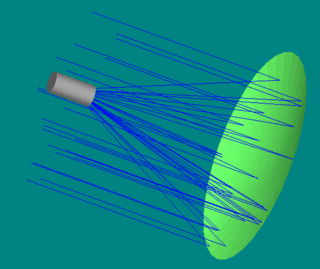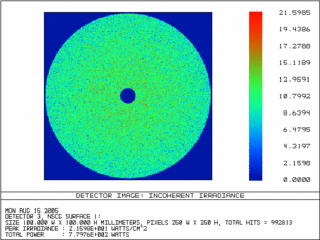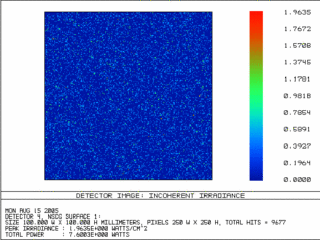When the sky is clear, light from the sun arrives in parallel rays that can be easily focused. For an example, I modeled a 1 m diameter parabolic mirror receiving 785.4 W of power (equivalent to 1000 W/m^2). I put a 10 cm diameter collector near the focus to collect the light.

A detector on the end of my collector can record the irradiance map.

As you can see, the parabolic concentrator creates a nice, even irradiance on the collector. Most of the energy incident on the concentrator ends up on the collector, except for the occlusion in the center caused by the collector itself. Some 99.3 % of the incoming light ends up on the collector surface. In the real world, due to Rayleigh scattering off the atmosphere, performance is not quite this good.
However, when the sky clouds over, the amount of light scattered by the atmosphere increases enormously and the light that hits the Earth's surface is diffuse rather than specular. We all observe this through the obvious fact that there are no shadows when it's overcast. The impact on the performance of optics is dramatic. I won't bother showing a ray trace, since it looks like garbage, but when I diffuse the incoming light the concentrator performance drops by two orders of magnitude.

The total irradiance on the detector has dropped from 780 W to 7.6 W. Obviously, this is no longer sufficient to drive a Stirling engine.
The local climate and in particular the clearness index is critical to determine if optics can be used to concentrate solar energy. The clearness index is the ratio of extra-atmospheric insolation to insolation measured at the Earth's surface. The ideal ratio is 1.0. Clearness index data (and lots of other solar relevent information) can be found at NASA's Surface Meteorology and Solar Energy website:
http://www.eso.org/gen-fac/pubs/astclim/espas/world/ION/ion-pwv.html
Some people have been working on non-focusing optics to achieve better economics. They often use thin refractive lenses to focus light to a slightly smaller blob. Generally these are designed to increase irradiance by a factor of four or so, not tens. The goal with non-focusing optics is to use a cheap concentrator to increase the irradiance on an expensive collector (like a photovoltaic cell).
For the curious, I used the optics modeling package Zemax to produce these results.
4 comments:
Stirling engine.
(Have some mercy on poor non-English speakers and machine translators.)
Would Sterling be translated as silver I wonder?
What about focusing using a lens rather than a mirror? Couldn't all incident light be focused on a small area, regardless of diffusion? The only problem would be the lower lux, right?
The mirrors can actually do worse than one sun. Lenses don't but they aren't really much better under diffuse conditions.
I'll do a thin-film refraction simulation some time. I also wonder if I can't simulate the effect of clearness index using HOMER.
Post a Comment